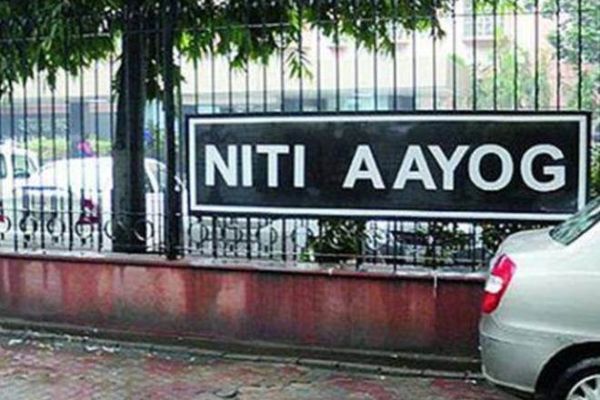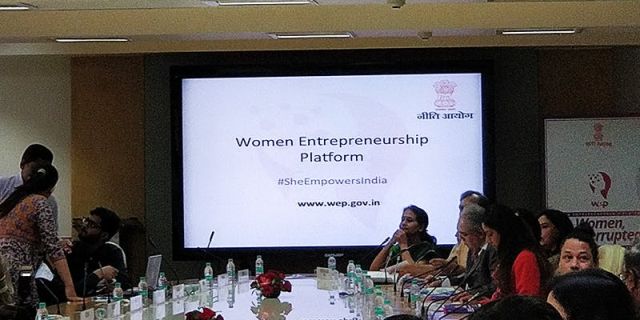
by Editor | May 25, 2021 | Corporate, Corporate Governance, Economy, News, Politics
 New Delhi : NITI Aayog has identified five sectors — healthcare, agriculture, education, smart cities and infrastructure and transportation — to focus its efforts towards implementation of artificial intelligence (AI) to serve societal needs.
New Delhi : NITI Aayog has identified five sectors — healthcare, agriculture, education, smart cities and infrastructure and transportation — to focus its efforts towards implementation of artificial intelligence (AI) to serve societal needs.
The government’s think-tank on Monday unveiled its discussion paper on national strategy on AI which aims to guide research and development in new and emerging technologies.
AI refers to the ability of machines to perform cognitive tasks like thinking, perceiving, learning, problem solving and decision making.
The paper focuses on how India can leverage the transformative technologies to ensure social and inclusive growth in line with the development philosophy of the government.
NITI Aayog CEO Amitabh Kant said AI should be leveraged to provide quality solutions across the identified sectors.
“The paper gives many disruptive suggestion including one to utilise market place models for data, annotation and deployable solutions in AI. We need to democratise access to and development of this technology,” he said in a tweet.
According to the NITI Aayog paper, while AI can increase access and affordability of quality healthcare; in agriculture, it can contribute towards enhancing farmers’ income, increase farm productivity and reduce wastage.
The paper added the technology can also improve access and quality of education, help build efficient infrastructure for the burgeoning urban population and develop smarter and safer modes of transportation to address traffic and congestion problems.
“Technology disruptions like AI are once-in-a-generation phenomenon, and hence large-scale adoption strategies, especially national strategies, need to strike a balance between narrow definitions of financial impact and the greater good,” it said.
“The strategy should strive to leverage AI for economic growth, social development and inclusive growth, and finally as a ‘garage’ for emerging and developing economies,” it added.
The paper has also identified some barriers that can prevent India from “truly reaping the benefits of deploying AI at scale”.
These barriers include lack of broad based expertise in research and application of AI, absence of access to intelligent data, high resource cost and low awareness for adoption of the technology and privacy and security issues.
The paper has proposed a two-tiered structure to address India’s AI research aspirations with setting up of a Centre of Research Excellence (CORE) and an International Centres of Transformational AI (ICTAI).
While the CORE will be focused on developing better understanding of existing core research and pushing technology frontiers through creation of new knowledge, the ICTAI will develop and deploy application-based research.
“Private sector collaboration is envisioned to be a key aspect of ICTAIs,” the paper said.
Finance Minister Arun Jaitley, in his last budget speech, had mandated the NITI Aayog to establish the national programme on AI to guide research and development in new and emerging technologies.
—IANS

by Editor | May 25, 2021 | Corporate, Corporate Governance, Economy, News, Politics
 Kolkata : NITI Aayog CEO Amitabh Kant on Thursday said the development agenda of 2022, “New India 2022”, will be prepared by June and given to Chief Ministers.
Kolkata : NITI Aayog CEO Amitabh Kant on Thursday said the development agenda of 2022, “New India 2022”, will be prepared by June and given to Chief Ministers.
“Development agenda of 2022 will be prepared by June and given to Chief Ministers. A number of other issues will also be discussed. Instead of the five-year plan, we are preparing a 15-year vision document, a development agenda by 2022 and three years action plan which is already in public domain,” Kant said.
Speaking during an interactive session organised by the Indian Chamber of Commerce here, Kant said the government was working on a specific action plan and policy and there will be global summit on Electric Vehicles in September.
He said artificial and blockchain technology offered a lot of opportunities.
“India must embrace artificial and blockchain technology. There will be no shortage of jobs but different types of job. India needs to reskill its people… There will be higher paid and skilled jobs,” he said.
Commenting on the Insolvency and Bankruptcy Code, Kant said the resolution for stressed assets would happen and the new mechanism would mature.
—IANS

by Editor | May 25, 2021 | Economy, News, Opinions
 By Alok Kumar, Neil Buddy Shah & Ronald Abraham,
By Alok Kumar, Neil Buddy Shah & Ronald Abraham,
The NITI Aayog recently launched the first round of ranking of India’s Aspirational Districts. The ranking, based on the socio-economic performance of 100+ districts, marks the initiation of a significant shift in development policy formulation in the country.
Over the years, India has focused much energy on fostering economic growth, and to good effect. As the recently released Economic Survey reports, the economy grew by over 7.5 per cent annually from 2011 to 2016, and is projected by the World Bank to be the fastest-growing major economy in the world over the next three years. This growth has lifted millions out of poverty, and bodes well for the future welfare of citizens.
However, economic growth cannot be sustained without a commensurate improvement in human capital, nor can the welfare of citizens improve through growth alone. We have a more sobre record in developing human capital. This is untenable and impedes genuine progress for India’s poor.
In education, thanks to Sarva Shiksha Abhiyaan, nearly all our children are accessing primary schools. However, retention and learning outcomes remain a challenge. In health, progress seems somewhat better, with infant mortality declining from 44 to 34 deaths per 1,000 births from 2011 to 2016. But India’s poorer neighbour, Bangladesh, has better health indicators .
How can we accelerate advancement of human capital as rapidly as we have economic growth? We argue that three fundamental changes in our approach to social policy are necessary. One, we need a shift in focus from inputs and budget outlays to social outcomes. Two, top-down policies should be eschewed in favour of local experimentation. Finally, a robust field data collection infrastructure that enables data-driven decision-making is required.
Such a transformational shift is precisely the goal of the government’s Aspirational Districts initiative. Anchored at NITI Aayog, this initiative aims to improve socio-economic outcomes in 100+ of India’s poorest districts, home to over 250 million people.
Under this initiative, districts will be ranked quarterly based on their ability to improve socio-economic outcomes. The rankings will be used to empower and incentivise District Collectors (DCs) to innovate and improve. And DCs will get policy guidance using evidence-backed best practices and a platform to learn from each other’s successes. Further, all tiers of government, a range of foundations, and civil society organisations are converging to support this initiative.
We are optimistic that the Aspirational Districts initiative can significantly augment socio-economic outcomes in India’s poorest regions. Below we analyse the three main policy shifts attempted by this initiative.
Traditionally, communication between government departments has largely revolved around inputs and prescriptive instructions. Thousands of reams of paper and meeting hours are expended to assess progress on budget line items and inputs, ranging from school walls to hospital beds.
The Aspirational Districts initiative’s exclusive focus on outcomes — the index for district ranking is built using only outcome indicators — is a breath of fresh air. Each district in terms of socioeconomic outcomes will be in the forefront of the agenda, rather than a footnote. Progress will be defined by achieving welfare targets, rather than budgetary ones. The conversation can gravitate to getting results for India’s citizens, rather than input-oriented reports.
Secondly, central government programmes are associated with prescriptive and rigid programme guidelines with little or no room for localisation. For example, the Right to Education Act gets into minutiae such as school boundary walls. MGNREGA guidelines cap the overhead ratio for all districts at the same level regardless of their size and labour demand. Many more examples abound.
For the Aspirational Districts initiative, there are no top-down guidelines. Instead, DCs will be provided with evidence-backed recommendations based on best practices and incentivised to tailor solutions based on the specific contexts of their districts. They are also empowered to go beyond these suggestions and innovate. This provides a rich laboratory of experiments from which ideas proven to be impactful can rise to the top.
Thirdly, development policy has traditionally been input-oriented and prescriptive because high-quality, regular and granular data on socio-economic outcomes were simply not available. A results-based management approach is only tenable if this data vacuum is filled. This data vacuum also helps explain why policymaking is anecdote-driven rather than data-driven, and why last-mile implementation failures go largely unaddressed.
The government’s administrative data is important, but cannot fully address this data gap. While administrative data is usually frequent (real-time dashboards) and granular (often up to village level), it suffers from biases because of employee self-reporting or other conflicts of interests. And while independent surveys like the National Family Health Survey have more reliable estimates, the data is available after long intervals and is usually only reported at the state level.
The Aspirational Districts initiative upends this lack of regular, high-quality, field-based granular data. NITI Aayog and its partners are setting up an independently-run data infrastructure with feet on the ground and technology-based management methods. This infrastructure will independently track household-level socio-economic data on health, education, financial inclusion, and many other sectors on a quarterly basis.
With a large sample of households in each district, this is a hitherto unmatched scope, scale and frequency of welfare measurement in the history of India’s development journey. The data, to be provided on a public dashboard, will not only aid this initiative but also the work of public sector officials, development practitioners, and researchers more broadly.
We are still in the early days of the Aspirational Districts initiative. We are cautiously optimistic that the pioneering policy shifts of this initiative will enable innovative solutions to improve the lives of our citizens and help create a new benchmark for policymaking in India.
(Alok Kumar [IAS] is Advisor, Health, at NITI Aayog. Neil Buddy Shah and Ronald Abraham are CEO and Partner at IDinsight, which provides analytical and impact measurement support for the Aspirational Districts initiative)
—IANS

by Editor | May 25, 2021 | Corporate, Corporate Governance, Entrepreneurship, News, Politics, Women Entrepreneur
 New Delhi : Industry lobbies like the Federation of Indian Chambers of Commerce and Industry (Ficci) and the National Association of Software and Services Companies (Nasscom) on Thursday announced tie-ups with NITI Aayog for the Women Entrepreneurship Platform (WEP) initiative.
New Delhi : Industry lobbies like the Federation of Indian Chambers of Commerce and Industry (Ficci) and the National Association of Software and Services Companies (Nasscom) on Thursday announced tie-ups with NITI Aayog for the Women Entrepreneurship Platform (WEP) initiative.
The NITI Aayog’s WEC initiative aims to promote and support established as well as aspiring women entrepreneurs in India and create a vibrant entrepreneurial ecosystem where women do not face any gender-based barriers.
“Through a joint programme, Ficci and NITI Aayog shall provide hand-holding, mentorship, capacity building, scaling up and networking support to 100 technology led women enterprises over a period of five years,” Ficci said in a statement.
It added that Ficci and NITI Aayog will also undertake policy advocacy towards formulation of policies and schemes that foster women entrepreneurship by identifying the existing gaps.
“Ficci is fully committed to work with NITI Aayog towards strengthening the entrepreneurship ecosystem for women in particular,” said Nirankar Saxena, Deputy Secretary General, Ficci.
“The women entrepreneurship ecosystem across the world has immense potential but is faced with financial and social barriers. Our aim is to provide a level playing field to women entrepreneurs,” Saxena added.
In another move, IT body Nasscom said it has entered into a partnership with NITI Aayog to provide a continuous stimuli for innovation and growth among the women entrepreneurs in the country.
“Nasscom through its start-up warehouses in 10 states would make available space for 15 women entrepreneurs led start-up across locations on a nominal charges basis, providing top class infrastructure, high-end technology and field expertise, and curated programmes to augment the growth of these women entrepreneurs,” Nasscom said in a separate statement.
Debjani Ghosh, President-Designate, Nasscom said: “India is now on its next growth curve, led by disruptive technologies like data sciences and AI and women in our country have been leading the growth to the next level.”
“The vision behind this initiative is to consolidate and streamline efforts in this space by building state-of-the-art infrastructure to amplify the impact that Women entrepreneurs in India can indigenously create,” Ghosh added.
—IANS

by Editor | May 25, 2021 | Opinions
 By Jai Sharda,
By Jai Sharda,
India’s Niti Aayog created ripples when it revealed a vision to completely switch automobile sales in India to electric vehicles (EVs) by 2030. EVs would obviously have a large impact on the environment. However, there are significant financial benefits attached to this transition as well: An EV owner could save close to Rs 37,000 (over $580) annually if India meets its renewable energy (RE) targets.
According to a paper by the Lawrence Berkeley National Laboratory, an EV owner is expected to save Rs 9,200 each year, even after including the higher capital cost of an EV over a traditional internal combustion engine (ICE) vehicle. However, some of the assumptions by the Berkeley lab were quite conservative. Building on that model, we used comparatively less conservative assumptions in terms of crude oil price, wind and solar installations.
The Berkeley study assumes no increase in the cost of international crude oil. Also, the study considers the base case as one with only 39 GW of installed solar capacity and 58 GW of installed wind capacity by 2030. However, India’s rapid progress in RE installation — 16.6 GW of solar capacity and 32.7 GW wind capacity in 2017 — itself indicates that it is well on its way to achieving an energy generation profile with a large amount of RE-based generation.
If India is able to install the targeted 180 GW solar and 110 GW wind power by 2030, the output from these two sources would be around 18 per cent of the total electricity generation. This is significant because while the average cost of electricity generated by solar and wind power are expected to fall to +/- Rs 1.71 and Rs 1.57, respectively, the cost of electricity from non-RE sources is expected to rise to Rs 4.57 by 2030, even by conservative assumptions. With this, the average cost of electricity produced in India would be around Rs 5.0/kWh.
With these costs, an EV owner would be able to save over Rs 36,700 per year in fuel costs over an ICE vehicle. With the difference in the capital costs of both vehicles expected to be in the range of Rs 1.08 lakh, an EV owner would be able to recover the incremental cost of his vehicle within just a year. In case the entire electricity consumption for EV vehicles were to be sourced from RE sources, fuel cost savings could increase by another +/- eight per cent (INR 39,636).
At a national level, too, there will be a significant financial impact of this transition to EVs. Moving to EVs would help India reduce its crude oil consumption by 360 million barrels/year. Assuming that international crude oil prices continue to grow at their historical rate of 2.7 per cent and reach around $96/barrel by 2030, the move to EVs would help India save +/- $27.8 billion annually by 2030. Given both, the national balance of trade, as well as national energy security, this would be a massive step to achieving self-reliance in the energy sector.
(Jai Sharda is Managing Director, Equitorials, a financial research and solar energy firm. He can be contacted at jai@equitorials.com )
—IANS

 New Delhi : NITI Aayog has identified five sectors — healthcare, agriculture, education, smart cities and infrastructure and transportation — to focus its efforts towards implementation of artificial intelligence (AI) to serve societal needs.
New Delhi : NITI Aayog has identified five sectors — healthcare, agriculture, education, smart cities and infrastructure and transportation — to focus its efforts towards implementation of artificial intelligence (AI) to serve societal needs.

